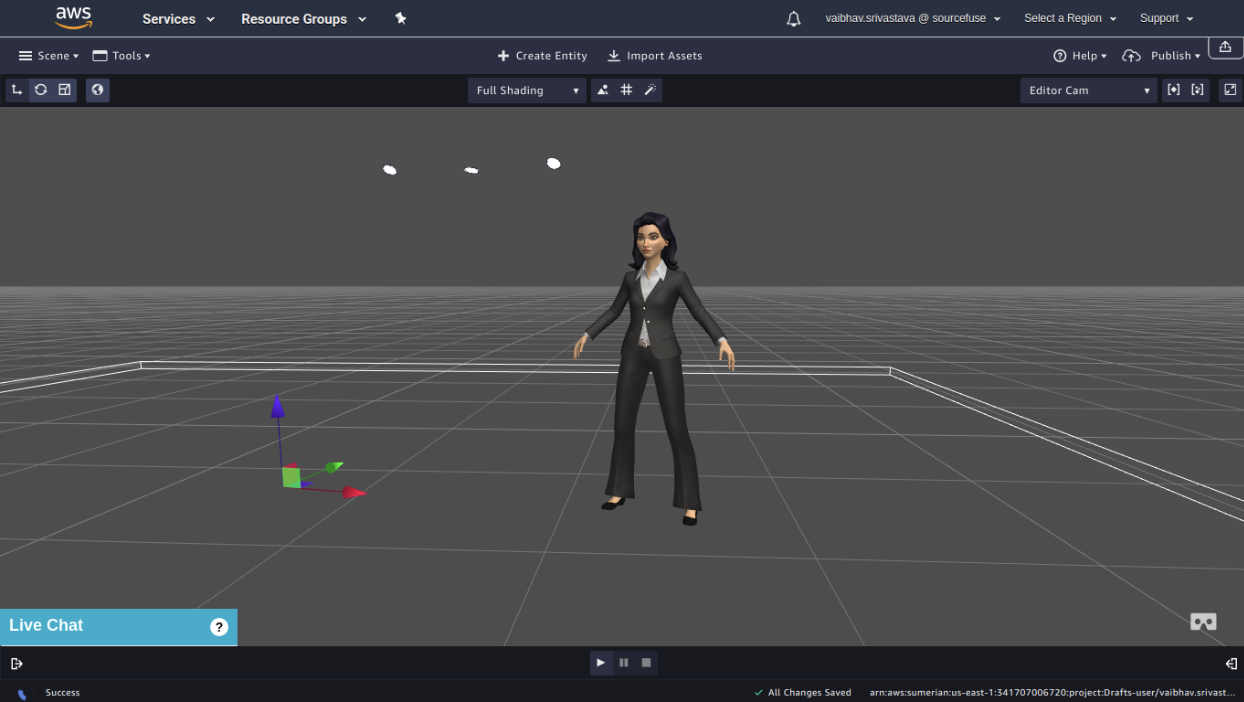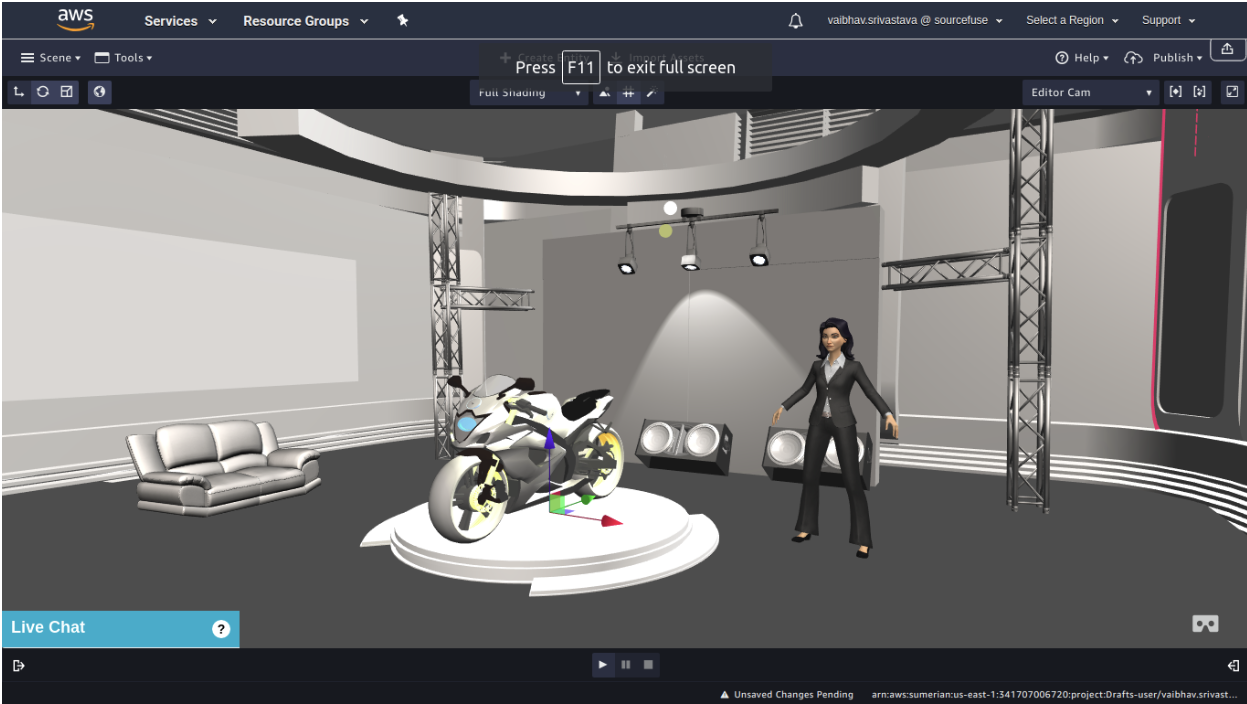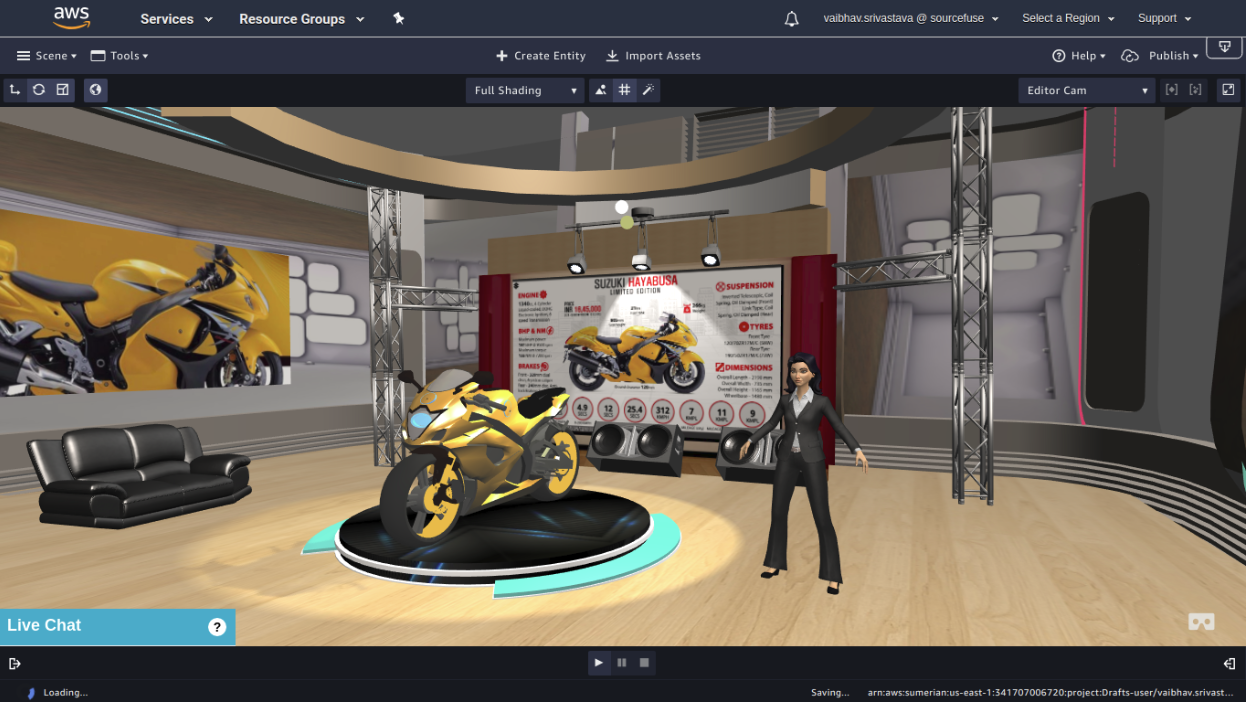Virtual and augmented reality are two very hot topics right now in marketing and business, and they’re slowly making their way into mainstream products. AR/VR is growing beyond the gaming industry, and VR is creating more and more business use cases for companies of every size to adopt this technology. While technology is making AR and VR experiences more accessible. This AWS Sumerian tutorial illustrates the ease and value of creating these experiences.
Fun Fact: Worldwide Spending on Augmented and Virtual Reality to Achieve a Five-Year CAGR of 71.6% by 2022, according to IDC.
Such is the case with AWS (Amazon Web Services) and Amazon Sumerian, allowing you to run virtual reality (VR), augmented reality (AR), and 3D applications quickly and without any specialized graphics expertise.
The Difference Between AR and VR
Augmented Reality (AR) is right there on your smartphone. It turns digital elements into real life entities giving you spellbound experiences. For instance, Snapchat uses this concept for its unconventional filters. Another example would be the game ‘Pokemon Go’ that brings characters to life.
Virtual Reality (VR) is meant to transport you to a virtual world completely, allowing you to witness a surreal experience that cuts out the real world entirely. HTC Vive, Oculus Rift or Google Cardboard are some devices used to transport you to the land of the polar bear or perhaps, to the moon.
There is another reality experience called ‘Mixed Reality’ that combines the elements of both AR and VR. Microsoft has a product in this arena by the name ‘HoloLens’ which already has a version 2 now.
Microsoft HoloLens 2 is a pair of mixed reality smart glasses developed and manufactured by Microsoft. It is the successor to the pioneering Microsoft HoloLens.
Microsoft highlighted three main improvements made to the device: immersiveness, ergonomics and business friendliness.
Mixed reality on HoloLens 2 combines an untethered device with apps and solutions that help people across your business learn, communicate, and collaborate more effectively. It’s the culmination of breakthroughs in hardware design, artificial intelligence (AI), and mixed reality development.
In the AR/VR arena, AWS has its own counterpart called ‘AWS Sumerian’.
What is Sumerian Technology and how did AWS come up with it?
Amazon Sumerian lets you create virtual reality (VR) and augmented reality (AR) scenes that are made up of components and entities, organized into projects. There are Sample Scenes ready for you to use, and plenty of AWS Sumerian tutorials available to help you learn on your own. To create experiences that work with any WebGL compatible browser like Chrome or Firefox, and three Sumerian Hosts ready to be customized. Sumerian provides a complete set of tools to create AR/VR/3D experiences.
How does Sumerian Technology Work?
The best part about AWS Sumerian is that you do not need to be a hardcore programmer to create interactive VR. To animate objects and respond to user actions like clicks and other movements, you need to use the built-in state machine. AWS Sumerian gives a library for advanced scripting with JavaScript. There is a ‘web-based editor’ provided for constructing 3D scenes with animation, scripted interaction, and special effects. The editor will run in your web browser, and all of your data is stored in AWS. For creating AR applications also, you can make use of AWS Sumerian use cases. An AR application can use your smartphone’s camera or an AR-compatible headset to cover the graphics on the real world.
What is a Host?
A host is an asset provided by Sumerian that has built-in animation, speech, and behavior for interacting with users. Sumerian Hosts are integrated with Automatic Speech Recognition(ASR) services, namely, Amazon Polly and Lambda.
You can use hosts to interact with users and take them through a VR experience. If you have 3D models of your own, you can import them with their animations and textures by dragging them from your file system into the editor canvas. Sumerian supports models in specifically, OBJ and FBX formats.
Note: As with many other AWS services, Sumerian is “free” to use: you pay only for the storage used in what you create. For a detailed step-by-step guide to AWS
Sumerian: Sumerian tutorials and samples.
What did We Make with VR?
Recently, SourceFuse created a VR assistant using Sumerian Technology under the guidance of our Senior Web apps Engineer, Mr Akhilesh Kumar.
According to Akhilesh, “ Initially we faced certain issues regarding the assistant’s practicality. After understanding the entire process and actually creating one with the help of AWS Sumerian, we are confident about the usability of Christine (VR Assistant).”
About Christine:
Christine is our VR Assistant that was built using AWS Sumerian Technology.
Our VR Assistant, Christine, was made in perpetually a time span of three weeks. Now that we have learned the crux of Sumerian technology, our developers can build it in one week. To view how she looks and talks, click below.
Christine: Sumerian App
Technical Details:
Along with using AWS Sumerian, Amazon Polly and Amazon Lex were also used by us for adding speech and natural language to the model. AWS Lambda was also used with the scripting library to access a whole range of AWS Services.
Design Series:
Here are a few pictures with the design stage mentioned below each image for your reference. All these 3-D images were created with 3D-Maya, a very subtle, yet precise computer animation software. Further, all of those infographics were imported onto Sumerian.



Note: These designs can also be made using other software such as FBX, OBJ, from where your avatar can be imported easily onto the Sumerian Technology.
Business Value of AR/VR
Did you know? The Compound Annual Growth Rate of the AR/VR industry is expected to be in the range of 40%-80%. Predictions have a huge range from $34 billion all the way up to $547 billion.
The business value of AR/VR has increased to a substantial level giving rise to a number of real-time use cases such as:
Data Visualisation through AR/VR is far more diverse than just the old pie charts. Now, you can view data in 3D displays, which can then be interacted with in a dynamic manner.
AR/VR has a large purpose to serve in brick & mortar shops through the heat mapping technology. Nowadays, many grocery stores use devices with built-in AR/VR that help them get to know various statistics related to their customer’s interests in their products.
In the field of Real Estate, AR/VR is widely used to provide customers with a real-time experience of their future house or any other infrastructure.
Multiple offices have housed a few AR/VR games for their employees to unwind in the most fun way possible.
Summary
On the last note, we have come to realize that ironically, building VR in today’s day and age is easier than writing a blog on an AWS Sumerian tutorial. Hence, we have decided to keep on building more of AWS Sumerian use cases so that you can learn from them and make a few of your own.
There is a huge range of predictions for the AR/VR Market and it is kind of dependent on the growth of complementary technologies such as 5G and the revolutionizing of hardware tech needed for such giant tech developments.
Using Sumerian Technology for the first time, we have realized its power and its oncoming future scope. For now, you can play with the language, speech and outward form aspects of the 3D models. In the coming time, we are sure we will be able to add human sense into these creatures. Let’s hope for the best, shall we?